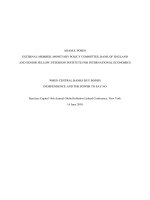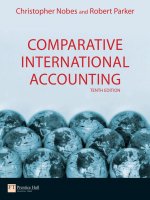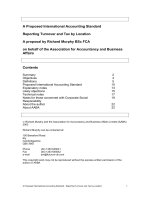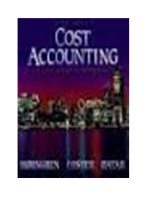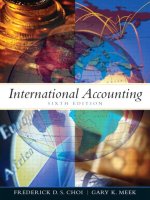Comparative international accounting pptx
Bạn đang xem bản rút gọn của tài liệu. Xem và tải ngay bản đầy đủ của tài liệu tại đây (6.68 MB, 626 trang )
COMPARATIVE
INTERNATIONAL
ACCOUNTING
Christopher Nobes and Robert Parker
TENTH EDITION
Christopher Nobes is Professor of Accounting at Royal Holloway, University of London. From 1993 to 2001 he was
a representative on the board of the International Accounting Standards Committee.
Robert Parker is Emeritus Professor of Accounting at the University of Exeter, UK. He was formerly editor of the
journal, Accounting and Business Research.
Both authors have received the American Accounting Association’s award of ‘outstanding international accounting
educator’.
Revised resources for lecturers are available to download at www.pearsoned.co.uk/nobes.
an imprint of
www.pearson-books.com
Front cover image: © Getty Images/Iconica
Now in its tenth edition, Comparative International Accounting by Nobes and Parker is renowned for
its depth of discussion and comprehensive coverage of the international dimensions of nancial
accounting and reporting.
It uncovers the conceptual and contextual foundations of the increasingly used International
Financial Reporting Standards (IFRS) and contrasts them with US generally accepted accounting
principles (GAAP). Nobes and Parker examine the key issues inherent in the subject, such as transition,
harmonization and political lobbying, and the international dierences that remain. They also look at the
special accounting problems of multinational companies.
Comparative International Accounting has been extensively revised for the many changes in international
accounting since the last edition.
New to this edition are:
An additional chapter on how the practice of IFRS
can vary within a country and between countries
Updated case studies and an increased number of
real-world examples
New information on pension accounting, auditing
standards and IFRS 8
Increased coverage of China and of small and
medium enterprises (SMEs)
Contributions from a diverse group of international
practitioners and academics, which are updated
every two years to incorporate the latest
developments in the eld
•
•
•
•
•
COMPARATIVE
INTERNATIONAL ACCOUNTING
TENTH
EDITION
Nobes
Parker
CVR_NOBE4767_10_SE_CVR.indd 1 25/3/08 14:50:00
COMPARATIVE
INTERNATIONAL ACCOUNTING
CIA_A01.qxd 12/14/08 11:15 AM Page i
We work with leading authors to develop the strongest
educational materials in business and finance, bringing
cutting-edge thinking and best learning practice to a
global market
Under a range of well-known imprints, including
Financial Times Prentice Hall, we craft high quality print
and electronic publications which help readers to understand
and apply their content, whether studying or at work
To find out more about the complete range of our
publishing, please visit us on the World Wide Web at:
www.pearsoned.co.uk
CIA_A01.qxd 12/14/08 11:15 AM Page ii
Tenth Edition
COMPARATIVE
INTERNATIONAL
ACCOUNTING
Christopher Nobes
and
Robert Parker
CIA_A01.qxd 12/14/08 11:15 AM Page iii
Pearson Education Limited
Edinburgh Gate
Harlow
Essex CM20 2JE
England
and Associated Companies throughout the world
Visit us on the World Wide Web at:
www.pearsoned.co.uk
First edition published in Great Britain under the Philip Allan imprint 1981
Second edition published 1985
Third edition published under the Prentice Hall imprint 1991
Fourth edition published 1995
Fifth edition published under the Prentice Hall imprint 1998
Sixth edition published 2000
Seventh edition published 2002
Eighth edition published 2004
Ninth edition published 2006
Tenth edition published 2008
© Prentice Hall Europe 1991, 1995, 1998
© Pearson Education Limited 2000, 2002, 2004, 2006, 2008
Chapter 18 © John Flower 2002, 2004, 2006, 2008
The rights of Christopher Nobes and Robert Parker to be identified as authors
of this work have been asserted by them in accordance with the Copyright,
Designs and Patents Act 1988.
All rights reserved. No part of this publication may be reproduced, stored in a
retrieval system, or transmitted in any form or by any means, electronic, mechanical,
photocopying, recording or otherwise, without either the prior written permission of the
publisher or a licence permitting restricted copying in the United Kingdom issued by
the Copyright Licensing Agency Ltd, 6–10 Kirby Street, London EC1N 8TS.
ISBN: 978-0-273-71476-7
British Library Cataloguing-in-Publication Data
A catalogue record for this book is available from the British Library
Library of Congress Cataloging-in-Publication Data
Comparative international accounting / [edited by] Christopher Nobes
and Robert Parker. – 10th ed.
p. cm.
Includes bibliographical references and index.
ISBN-13: 978-0-273-71476-7 (alk. paper) 1. Comparative accounting.
I. Nobes, Christopher. II. Parker, R. H. (Robert Henry)
HF5625.C74 2008
657—dc22
2008007524
1098765432
12 11 10 09
Typeset in 9.5/12.5pt Stone Serif by 35
Printed by Ashford Colour Press Ltd., Gosport
The publisher’s policy is to use paper manufactured from sustainable forests.
CIA_A01.qxd 12/14/08 11:15 AM Page iv
v
Contributors xvi
Preface xviii
Part I SETTING THE SCENE
1 Introduction 3
2 Causes and examples of international differences 24
3 International classification of financial reporting 51
4 International harmonization 74
Part II FINANCIAL REPORTING BY LISTED GROUPS
5 The context of financial reporting by listed groups 101
6 The requirements of International Financial Reporting Standards 117
7 Different versions of IFRS practice 145
8 Financial reporting in the United States 157
9 Enforcement of Financial Reporting Standards 189
10 Political lobbying on Accounting Standards – US, UK and
international experience 206
Part III HARMONIZATION AND TRANSITION IN EUROPE
AND EAST ASIA
11 Harmonization and transition in Europe 237
12 Harmonization and transition in East Asia 257
Part IV FINANCIAL REPORTING BY INDIVIDUAL COMPANIES
13 The context of financial reporting by individual companies 285
14 Making accounting rules for non-listed business enterprises in Europe 293
15 Accounting rules and practices of individual companies in Europe 314
Part V MAJOR ISSUES IN FINANCIAL REPORTING BY MNEs
16 Key financial reporting topics 343
Brief contents
CIA_A01.qxd 12/14/08 11:15 AM Page v
Brief contents
vi
17 Consolidation 368
18 Foreign currency translation 384
19 Segment reporting 427
Part VI ANALYSIS AND MANAGEMENT ISSUES
20 International financial analysis 457
21 International auditing 481
22 International aspects of corporate income taxes 510
23 Managerial accounting 531
Glossary of abbreviations 558
Suggested answers to some of the end-of-chapter questions 563
Author index 583
Subject index 587
Supporting resources
Visit www.pearsoned.co.uk/nobes to find valuable
online resources
For instructors
■
Complete, downloadable Instructor’s Manual,
including answers to the end of chapter questions
in the text, additional questions for further study and multiple choice questions
(with answers).
■
PowerPoint slides of the figures and tables in the book that can be downloaded
and used as OHTs
For more information please contact your local Pearson Education sales representative
or visit www.pearsoned.co.uk/nobes.
Convenience. Simplicity. Success.
CIA_A01.qxd 12/14/08 11:15 AM Page vi
vii
Contributors xvi
Preface xviii
Part I SETTING THE SCENE
1 Introduction 3
Contents 3
Objectives 3
1.1 Differences in financial reporting 4
1.2 The global environment of accounting 5
1.3 The nature and growth of MNEs 12
1.4 Comparative and international aspects of accounting 15
1.5 Structure of this book 18
Summary 21
References 21
Useful websites 22
Questions 22
2 Causes and examples of international differences 24
Contents 24
Objectives 24
2.1 Introduction 25
2.2 Culture 25
2.3 Legal systems 28
2.4 Providers of finance 29
2.5 Taxation 33
2.6 Other external influences 35
2.7 The profession 36
2.8 Conclusion on the causes of international differences 37
2.9 Some examples of differences 38
Summary 46
References 47
Questions 50
Contents
CIA_A01.qxd 12/14/08 11:15 AM Page vii
Contents
viii
3 International classification of financial reporting 51
Contents 51
Objectives 52
3.1 Introduction 52
3.2 The nature of classification 53
3.3 Classifications by social scientists 53
3.4 Classifications in accounting 55
3.5 Extrinsic classifications 56
3.6 Intrinsic classifications: 1970s and 1980s 60
3.7 Developments related to the Nobes classification 66
3.8 Further intrinsic classification 67
3.9 Is there an Anglo-Saxon group? 69
3.10 A taxonomy of accounting classifications 69
Summary 70
References 71
Questions 73
4 International harmonization 74
Contents 74
Objectives 74
4.1 Introduction 75
4.2 Reasons for, obstacles to and measurement of harmonization 76
4.3 The International Accounting Standards Committee 78
4.4 Other international bodies 87
4.5 The International Accounting Standards Board 91
Summary 94
References 95
Useful websites 97
Questions 98
Part II FINANCIAL REPORTING BY LISTED GROUPS
5 The context of financial reporting by listed groups 101
Contents 101
Objectives 101
5.1 Introduction 101
5.2 IFRS in the EU 102
5.3 Adoption of, and convergence with, IFRS 105
5.4 Foreign listing and foreign investing 106
5.5 Reconciliations from national rules to US GAAP and IFRS 108
5.6 High-level IFRS/US differences 110
CIA_A01.qxd 12/14/08 11:15 AM Page viii
Contents
ix
5.7 Reconciliations from IFRS to US GAAP 111
5.8 Convergence of IFRS and US GAAP 113
Summary 114
References 115
Useful websites 116
Questions 116
6 The requirements of International Financial
Reporting Standards
117
Contents 117
Objectives 118
6.1 Introduction 118
6.2 The conceptual framework and some basic standards 118
6.3 Assets 125
6.4 Liabilities 128
6.5 Group accounting 130
6.6 Disclosures 131
Summary 132
References 132
Further reading 133
Useful websites 133
Questions 133
Appendix 6.1 An outline of the content of International
Financial Reporting Standards 134
7 Different versions of IFRS practice 145
Contents 145
Objectives 145
7.1 Introduction 145
7.2 Motivations for different IFRS practice 146
7.3 Scope for different IFRS practice 148
7.4 Conclusion 154
Summary 155
References 155
Questions 156
8 Financial reporting in the United States 157
Contents 157
Objectives 158
8.1 Introduction 158
8.2 Regulatory framework 159
CIA_A01.qxd 12/14/08 11:15 AM Page ix
Contents
x
8.3 Accounting standard-setters 163
8.4 The conceptual framework 166
8.5 Contents of annual reports 169
8.6 Accounting principles 174
8.7 Consolidation 181
8.8 Audit 183
8.9 Differences from IFRS 184
Summary 186
References 186
Further reading 187
Useful websites 188
Questions 188
9 Enforcement of Financial Reporting Standards 189
Contents 189
Objectives 189
9.1 Introduction 189
9.2 Modes and models of enforcement 190
9.3 United States 194
9.4 European Union 195
9.5 Australia 201
Summary 202
References 202
Useful websites 204
Questions 205
10 Political lobbying on Accounting Standards – US,
UK and international experience 206
Contents 206
Objectives 206
10.1 Introduction 207
10.2 Motivations for political lobbying 208
10.3 Political lobbying up to 1990 210
10.4 US political lobbying from 1990 220
10.5 Political lobbying of the IASC/IASB 224
10.6 Preparer attempts to control the accounting standard-setter 228
10.7 Political lobbying of the FASB’s convergence with the IASB 229
10.8 Some concluding remarks 231
Summary 231
References 232
Useful websites 234
Questions 234
CIA_A01.qxd 12/14/08 11:15 AM Page x
Contents
xi
Part III HARMONIZATION AND TRANSITION IN EUROPE
AND EAST ASIA
11 Harmonization and transition in Europe 237
Contents 237
Objectives 237
11.1 Introduction 238
11.2 Harmonization within the European Union 238
11.3 Transition in Central and Eastern Europe 244
Summary 253
References 253
Useful websites 256
Questions 256
12 Harmonization and transition in East Asia 257
Contents 257
Objectives 257
12.1 Introduction 258
12.2 Japan 258
12.3 China 272
Summary 277
References 278
Further reading 280
Useful websites 280
Questions 280
Appendix 12.1 ASBE Standards 282
Part IV FINANCIAL REPORTING BY INDIVIDUAL COMPANIES
13 The context of financial reporting by
individual companies
285
Contents 285
Objectives 285
13.1 Introduction 285
13.2 Outline of differences between national rules and
IFRS or US GAAP 286
13.3 The survival of national rules 286
13.4 Financial reporting, tax and distribution 289
13.5 Special rules for small or unlisted companies 290
Summary 292
References 292
CIA_A01.qxd 12/14/08 11:15 AM Page xi
Contents
xii
Useful websites 292
Questions 292
14 Making accounting rules for non-listed business
enterprises in Europe
293
Contents 293
Objectives 293
14.1 Introduction 293
14.2 Who makes accounting rules? 294
14.3 Which business enterprises are subject to accounting rules? 303
Summary 307
References 308
Further reading 309
Useful websites 310
Questions 311
Appendix 14.1 Contents of the Plan comptable général 312
Appendix 14.2 Financial accounting chart of accounts 313
15 Accounting rules and practices of individual
companies in Europe
314
Contents 314
Objectives 314
15.1 Introduction 314
15.2 France 315
15.3 Germany 319
15.4 United Kingdom 324
Summary 326
References 326
Further reading 327
Useful websites 327
Questions 327
Appendix 15.1 Formats for French financial statements 328
Appendix 15.2 Formats for German financial statements 333
Appendix 15.3 Formats for British financial statements 336
Part V MAJOR ISSUES IN FINANCIAL REPORTING BY MNEs
16 Key financial reporting topics 343
Contents 343
Objectives 343
16.1 Introduction 344
CIA_A01.qxd 12/14/08 11:15 AM Page xii
Contents
xiii
16.2 Recognition of intangible assets 344
16.3 Asset measurement 345
16.4 Financial instruments 347
16.5 Provisions 350
16.6 Employee benefits 354
16.7 Deferred tax 358
16.8 Revenue recognition 362
16.9 Comprehensive income 364
Summary 365
References 366
Questions 366
17 Consolidation 368
Contents 368
Objectives 368
17.1 Introduction 369
17.2 Rate of adoption 369
17.3 The concept of a ‘group’ 370
17.4 Harmonization from the 1970s onwards 371
17.5 Definitions of group companies 375
17.6 Publication requirements and practices 376
17.7 Techniques of consolidation 377
Summary 381
References 382
Further reading 382
Questions 382
18 Foreign currency translation 384
Contents 384
Objectives 385
18.1 Introduction 385
18.2 Translation of transactions 389
18.3 Introduction to the translation of financial statements 395
18.4 The US initiative 398
18.5 The temporal method versus the closing rate method 401
18.6 FAS 52 406
18.7 IAS 21 409
18.8 Translation of comprehensive income 411
18.9 Accounting for translation gains and losses 413
18.10 Research findings 419
18.11 An alternative to exchange rates? 423
Summary 423
References 424
CIA_A01.qxd 12/14/08 11:15 AM Page xiii
Contents
xiv
Further reading 425
Questions 425
19 Segment reporting 427
Contents 427
Objectives 427
19.1 What is segment reporting? 427
19.2 The need for segment information 432
19.3 Disclosure regulations 433
19.4 Evidence on the benefits of segment reporting 443
Summary 450
References 451
Questions 453
Part VI ANALYSIS AND MANAGEMENT ISSUES
20 International financial analysis 457
Contents 457
Objectives 457
20.1 Introduction 458
20.2 Understanding differences in accounting 458
20.3 Disclosure practices in international financial reporting 463
20.4 Interpreting financial statements 470
20.5 Financial analysis and the capital market 474
Summary 477
References 478
Useful websites 480
Questions 480
21 International auditing 481
Contents 481
Objectives 481
21.1 Introduction 482
21.2 Reasons for the internationalization of auditing 484
21.3 Promulgating international standards 489
21.4 The international audit process 495
Summary 507
References 508
Further reading 508
Useful websites 508
Questions 509
CIA_A01.qxd 12/14/08 11:15 AM Page xiv
Contents
xv
22 International aspects of corporate income taxes 510
Contents 510
Objectives 510
22.1 Introduction 511
22.2 Tax bases 513
22.3 International tax planning 517
22.4 Transfer pricing 518
22.5 Tax systems 519
22.6 Harmonization 525
Summary 527
References 527
Further reading 529
Useful websites 529
Questions 529
23 Managerial accounting 531
Contents 531
Objectives 531
23.1 Introduction 532
23.2 The balanced scorecard as an overview tool 533
23.3 Currency and control 535
23.4 Variances and foreign exchange 539
23.5 Culture and management accounting 540
23.6 Control and performance 549
23.7 Looking forward 551
Summary 553
References 554
Questions 557
Glossary of abbreviations 558
Suggested answers to some of the end-of-chapter questions 563
Author index 583
Subject index 587
CIA_A01.qxd 12/14/08 11:15 AM Page xv
xvi
Co-editor, author of Chapters 2, 3, 4, 5, 6, 7, 8, 12, 13, 16 and 22, and co-author of
Chapter 17
Christopher Nobes Professor of Accounting at Royal Holloway College, Univer-
sity of London. He has also taught in Australia, Italy, the Netherlands, New Zealand,
Scotland, Spain and the United States. He is currently a visiting professor at the
Norwegian School of Management. He was the 2002 ‘Outstanding International
Accounting Educator’ of the American Accounting Association. He was a member
of the Accounting Standards Committee of the United Kingdom and Ireland from
1986 to 1990, and a UK representative on the Board of the International Accounting
Standards Committee from 1993 to 2001. He is vice-chairman of the accounting
committee of the Fédération des Experts Comptables Européens.
Co-editor, author of Chapters 1, 9, 11, 14 and 15, and co-author of Chapter 17
Robert Parker Emeritus Professor of Accounting at the University of Exeter and
former professorial fellow of the Institute of Chartered Accountants of Scotland.
He has also practised or taught in Nigeria, Australia, France and Scotland and was
editor or joint editor of Accounting and Business Research from 1975 to 1993. He was
the British Accounting Association’s ‘Distinguished Academic of the Year’ in 1997,
and the 2003 ‘Outstanding International Accounting Educator’ of the American
Accounting Association.
Authors of other chapters
Jan Buisman IFRS Senior Technical Partner for PricewaterhouseCoopers in
Sweden and partner in the firm’s Global Corporate Reporting Group. He was for-
merly the Netherlands representative on the International Auditing Practices
Committee, and chairman of Royal NIVRA’s Auditing Standards Board. He is now
chairman of the Accounting Practices Committee of FAR in Sweden. (Co-author of
Chapter 21)
John Flower Formerly, Director of the Centre for Research in European Account-
ing (Brussels), and earlier with the Commission of the European Communities and
Professor of Accounting at the University of Bristol. He now lives in Germany.
(Chapter 18)
Graham Gilmour Senior Manager in the Global Corporate Reporting Group of
PricewaterhouseCoopers. (Co-author of Chapter 21)
Stuart McLeay Professor of Treasury at the University of Wales, Bangor. Formerly,
he worked as a chartered accountant in Germany, France and Italy, and was a finan-
cial analyst at the European Investment Bank. Co-editor of the ICAEW European
Financial Reporting series. (Chapter 20)
Contributors
CIA_A01.qxd 12/14/08 11:15 AM Page xvi
Contributors
xvii
Clare B. Roberts Professor of Accounting at the University of Aberdeen Business
School. (Chapter 19)
Stephen Salter Associate Professor and Director of the Center for Global Com-
petitiveness at the University of Cincinnati. Formerly, he was a partner at Ernst &
Young Management Consultants. (Chapter 23)
Stephen A. Zeff Herbert S. Autrey Professor of Accounting at Rice University.
(Chapter 10)
CIA_A01.qxd 12/14/08 11:15 AM Page xvii
xviii
Purpose
Comparative International Accounting is intended to be a comprehensive and coher-
ent text on international financial reporting. It is primarily designed for under-
graduate and postgraduate courses in comparative and international aspects of
accounting. We believe that a proper understanding requires broad overviews (as in
Part I), but that these must be supported by detailed information on real countries
and companies (as in Parts II to IV) and across-the-board comparisons of major
topics (as in Parts V and VI).
This book was first published in 1981. This present edition (the tenth) is a com-
plete updating of the ninth edition which constituted the most extensive revision
that we had ever made. One chapter (7) has been added: an examination of the pos-
sible motivations and opportunities for different national versions of IFRS practice.
A revised manual for teachers and lecturers is available from http://www.
pearsoned.co.uk/nobes. It contains several numerical questions and a selection of
multiple-choice questions. Suggested answers are provided for all of these and for
the questions in the text. In addition, there is now an extensive set of PowerPoint
slides.
Authors
In writing and editing this book, we have tried to gain from the experience of those
with local knowledge. This is reflected in the nature of those we thank below for
advice and in our list of contributors. For example, the original chapter on North
America was co-authored by a Briton who had been assistant research director of
the US Financial Accounting Standards Board; his knowledge of US accounting was
thus interpreted through and for non-US readers. The amended version is by one of
the editors, who has taught in several US universities. This seems the most likely
way to highlight differences and to avoid missing important points through over-
familiarity. The chapter on political lobbying has been written by Stephen Zeff, an
American who is widely acknowledged as having the best overview of historical and
international accounting developments. Other contributors presently live or work
in Germany, in Sweden and in the United States.
Structure
Part I sets the scene for a study of comparative international financial reporting.
Many countries are considered simultaneously in the introductory chapter and
when examining the causes of the major areas of difference (Chapter 2). It is then
Preface
CIA_A01.qxd 12/14/08 11:15 AM Page xviii
Preface
xix
possible to try to put accounting systems into groups (Chapter 3) and to take the
obvious next step by discussing the purposes and progress of international harmon-
ization of accounting (Chapter 4).
All this material in Part I can act as preparation for the other parts of the book.
Part I can, however, be fully understood only by those who become well-informed
about the contents of the rest of the book, and readers should go back later to
Part I as a summary of the whole.
Part II examines financial reporting by listed groups. In much of the world
this means, at least for consolidated statements, using the rules of either the
International Accounting Standards Board or the United States. In addition to an
overview and chapters on these two ‘systems’ of accounting, Part II also contains
a chapter on whether national versions of IFRS exist, one on enforcement of
accounting regulations, and one on political lobbying.
Part III contains two chapters that examine the processes of harmonization and
transition as applied in the EU and East Asia. Part IV concerns the financial report-
ing of individual companies, where large international differences remain. There
are three chapters: context, regulatory styles, and accounting differences.
Part V examines, broadly and comparatively, particular major financial reporting
topics: key non-consolidation issues, consolidation, foreign currency translation
and segment reporting. Part VI considers four issues of international analysis and
management: international financial analysis, international auditing, international
aspects of corporate income taxes, and managerial accounting.
At the end of the book, there is a glossary of abbreviations relevant to inter-
national accounting, suggested answers to some chapter questions, and two indexes
(by author and by subject).
Publisher’s acknowledgements
We are grateful to the following for permission to reproduce copyright material:
Table 1.4: United Nations Conference on Trade and Development (UNCTAD) (2007)
World Investment Report 2007: Transnational Companies, Exractive Industries and
Development. Geneva, UNCTAD. Copyright © United Nations 2007; Table 1.8:
United Nations Conference on Trade and Development (UNCTAD) (2007) World
Investment Report 2007: Transnational Companies, Exractive Industries and Develop-
ment. Geneva, UNCTAD. Copyright © United Nations 2007; Table 2.3: Source of
data: Datastream. Reproduced by kind permission of Jon Tucker and David Bence
of Bristol Business School; Figure 3.1: American Accounting Association (1977)
Accounting Review, Supplement to Vol. 52, 1977, p. 99. Copyright © 1977 American
Accounting Association. Reproduced with permission; Figure 3.2: Puxty, A.G.,
Willmott, H.C., Cooper, D.J. and Lowe, A.E. (1987) ‘Modes of regulation in
advanced capitalism: locating accountancy in four countries’, Accounting,
Organizations and Society, Vol. 12, No. 3, p. 283. Reproduced with permission of
Elsevier; Table 3.1: Nair, R.D. and Frank, W.G. (1980) ‘The impact of disclosure
and measurement practices on international accounting classifications’, Accounting
Review, Vol. 55, No. 3, p. 429. Reproduced with permission of the American
CIA_A01.qxd 12/14/08 11:15 AM Page xix
Preface
xx
Accounting Association; Table 5.3: Adapted from BASF (2005) BASF Annual Report
2004, pp. 92, 93, BASF SA, Ludwigshafen, Germany. Reproduced with permission;
Table 5.6: Extracted from the Bayer AG (2007) Bayer AG Annual Report 2006, Bayer
AG, Leverkusen, Germany. Reproduced with permission; Table 5.8: Adapted from
the Degussa AG (2005) Degussa AG Annual Report 2004, Degussa AG, Düsseldorf,
Germany. Reproduced with permission; Tables 7.1, 7.2 and 7.3: Nobes, C.W. (2006)
‘The survival of international differences under IFRS: towards a research agenda’,
Accounting and Business Research, Vol. 36, No. 3. Reproduced with permission; Table
8.2: American Institute of Certified Public Accountants (AICPA) (2006) Accounting
Trends and Techniques (issued annually). AICPA, Jersey City, New Jersey, p. 133.
Copyright © 2006 by the American Institute of Certified Public Accountants, Inc.
All rights reserved. Reprinted with permission; Table 8.3: American Institute of
Certified Public Accountants (2006) Accounting Trends and Techniques (issued annu-
ally). AICPA, Jersey City, New Jersey, p. 295. Copyright © 2006 by the American
Institute of Certified Public Accountants, Inc. All rights reserved. Reprinted with
permission; Table 8.4: American Institute of Certified Public Accountants (2006)
Accounting Trends and Techniques (issued annually). AICPA, Jersey City, New Jersey,
p. 273. Copyright © 2006 by the American Institute of Certified Public Accountants,
Inc. All rights reserved. Reprinted with permission; Table 8.5: American Institute of
Certified Public Accountants (2006) Accounting Trends and Techniques (issued annu-
ally). AICPA, Jersey City, New Jersey, p. 278. Copyright © 2006 by the American
Institute of Certified Public Accountants, Inc. All rights reserved. Reprinted with
permission; Table 8.8: American Institute of Certified Public Accountants (2006)
Accounting Trends and Techniques (issued annually). AICPA, Jersey City, New Jersey,
p. 153. Copyright © 2006 by the American Institute of Certified Public Accountants,
Inc. All rights reserved. Reprinted with permission; Table 13.1: Adapted from BASF
(2005) BASF Annual Report 2004, pp. 92, 93, BASF SA, Ludwigshafen, Germany.
Reproduced with permission; Table 13.2: Bayer AG (2005) Bayer AG Annual Report
2004, Bayer AG, Leverkusen, Germany, pp. 74–84. Reproduced with permission;
Figure 16.2: Adapted from FEE (1995) ‘A classification of non-state pension
schemes’ in Survey of Pensions and Other Retirement Benefits in EU and non-EU
Countries, Routledge, London. Reproduced with permission of the Taylor & Francis
Group, Ltd; Table 19.2: Honda (2007) Honda Annual Report 2006, Honda, Tokyo,
Japan, p. 63. Reproduced with permission; Table 20.4: The Volvo Group (2005) The
Volvo Group Financial Report, 2004, AB Volvo, Goteborg, Sweden. Reproduced with
permission; Table 23.1: Landry, S., Chan, W. and Jalbert, T. (2002) Balanced score-
card for multinationals, Journal of Corporate Accounting and Finance, p. 38. Copyright
© 2002 John Wiley & Sons. Reprinted by permission; Table 23.4: Derived from
Harrison, G. and McKinnon, J. (1999) ‘Cross-cultural research in management con-
trol systems design: A review of the current state’, Accounting, Organizations and
Society, Vol. 24, p. 486 where full references to cited papers are given. Reproduced
with permission from Elsevier.
In some instances we have been unable to trace the owners of copyright material,
and we would appreciate any information that would enable us to do so.
CIA_A01.qxd 12/14/08 11:15 AM Page xx
Preface
xxi
Other acknowledgements
In the various editions of this book, we have received great help and much useful
advice from many distinguished colleagues in addition to our contributors. We
especially thank Sally Aisbitt (deceased); Dr Ataur Rahman Belal, Aston Business
School, Aston University; Andrew Brown of Ernst & Young; John Carchrae of the
Ontario Securities Commission; Terry Cooke of the University of Exeter; John
Denman and Peter Martin of the Canadian Institute of Chartered Accountants;
Brigitte Eierle of Regensburg University; Maria Frosig, Niels Brock Copenhagen
Business School, Denmark; Michel Glautier of ESSEC; Dr Jing Hui Liu, University of
Adelaide, Australia; Horst Kaminski, formerly of the Institut der Wirtschaftsprüfer;
Jan Klaassen of the Free University, Amsterdam; Yannick Lemarchand of the
University of Nantes; Ken Lemke of the University of Alberta; Klaus Macharzina of
the University of Hohenheim; Malcolm Miller and Richard Morris of the University
of New South Wales; Geoff Mitchell, formerly of Barclays Bank; Jules Muis of
the European Commission; Ng Eng Juan of Nanyang Technological University of
Singapore; Graham Peirson of Monash University; Jacques Richard of the University
of Paris Dauphine; Alan Richardson of York University, Toronto; Alan Roberts of
the University of Rennes; Paul Rutteman, formerly of EFRAG; Etsuo Sawa, formerly
of the Japanese Institute of Certified Public Accountants; Hein Schreuder, formerly
of the State University of Limburg; Marek Schroeder of the University of
Birmingham; Patricia Sucher, formerly of Royal Holloway, University of London;
Lorena Tan, formerly of Price Waterhouse, Singapore; Ann Tarca of the University
of Western Australia; Peter van der Zanden, formerly of Moret Ernst & Young and
the University of Tilburg; Gerald Vergeer of Moret Ernst & Young; and Ruud
Vergoossen of Royal NIVRA and the Free University of Amsterdam; Dr Yap Kim Len,
HELP University College, Malaysia. We are also grateful for the help of many secret-
aries over the years.
Despite the efforts of all these worthies, errors and obscurities will remain, for
which we are culpable jointly and severally.
Christopher Nobes
Robert Parker
Universities of London
and Exeter
CIA_A01.qxd 12/14/08 11:15 AM Page xxi
CIA_A01.qxd 12/14/08 11:15 AM Page xxii
Part I
SETTING THE SCENE
CIA_C01.qxd 10/03/2008 16:30 Page 1
CIA_C01.qxd 10/03/2008 16:30 Page 2
